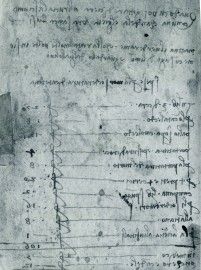
There is a Caterina appearing 4 times in Leonardo Da Vinci notebooks. The two most important notes are:
16 July/Caterina came, 16 July 1493. [i]
Here Leonardo simply says Caterina came and, perhaps, as a sign of his inner turmoil he repeated twice the date 16 July. Leonardo was in Milan since 1482 and in other instances when a person entered his entourage he always said ‘to stay with me’.
The last entry for Caterina is about her death. Leonardo left a detailed list of the expenses for her funeral and interment. But was this lady really his mother? We are sure that the answer is yes and we can demonstrate it: a fact that several important biographers of Leonardo had overlooked. Pointing at the list of the expenses for her funeral they have been arguing that Leonardo should have spent more for his mother or express more deeply his grief. But they forget that even when dealing with his father’s death Leonardo behave in a similar, reserved and apparently detached, fashion. We should also note that the list of expenses for her funeral is very detailed, and nothing similar could be found for other members of Leonardo’s family and circle of friends. Sigmund Freud had pointed out that looking at the list we should read a sort of soothing effect on his subconscious.
Here Leonardo was writing ‘expenses for the morte (death) of Caterina, but he cancelled the word morte and he wrote over it socteratura which means entombment.
Expenses for Caterina’s death entombment
For 3 pounds of wax s.27
For the bier s. 8
Pall over the bier s.12
Carriage and placing of a cross s. 4
For the bearers s. 8
For 4 priests and 4 clerks s.20
Bell, book, sponge, s. 2
For the gravediggers s.16
For the dean s. 8
For the licence s. 1
——
106
Doctor s. 5
Sugar and candles s.12
———
123 s.[ii]
This list which appears in the Codex Foster – under a receipt containing wax and lemon juice – includes expenses for a doctor, sugar, wax for the candles, bier with a cross, four priests and four altar boys, the bells, the grave diggers. People who don’t see in this Caterina the mother of Leonardo claim that the expenses were far too low for a mother. But 123 soldi were not a small amount at all, as Luca Beltrami had demonstrated in one of his essays.[iii] At that time, in Milan with 1 soldo you could buy one litre of wine or six eggs. The importance of this person should also be clear by the fact that Leonardo is summoning four priests to officiate at her funeral and, for a common servant, they were a bit too many.
A short note has emerged a few years ago in a document from the State Archives of Milan, written in Latin and dated 26 June 1494, concerning the death of a lady called Caterina from Florence.[iv]
In Die jovis 26 Iuniis P[orta] V[ercellina p[arochia] s[anctorum]. Naboris et Felicis. Chatarina de Florenzia annorum 60 a febre Ter[zan]a contr.a dupla iudicio m[agist].ri Concordi de Castrono – Decessit.
It says that on Thursday 26 June at the Parish of the Saints Nabore and Felix at Porta Vercellina, Caterina from Florence, 60 years old, died of malaria and then follow the name of the magistrate. Strangely for Milan the Tuscan spelling Chaterina instead of Caterina is maintained but perhaps Leonardo had provided documents she had carried, stating her identity with the Florentine’s spelling. Incidentally Leonardo was to receive a vineyard from Ludovico Sforza, with an official act dated 26 April 1499, right where the lady died, at Porta Vercellina and was probably close to Leonardo’s home.[v]
Caterina may have contracted malaria at the Padule di Fucecchio where it was endemic, if the diagnosis made by the doctor was correct. There is no record of another Caterina from Florence dying in Milan from 1494 onward. Therefore we may conclude that this lucky archival find finally closes the case once and for all: she was indeed the mother of Leonardo Da Vinci.
The first to raise such possibility, that she was indeed Leonardo Da Vinci’s mother, had been the Russian novelist and visionary intellectual Dmitrij Sergeevič Merežkovskij[vi] in his 1900’s novel Resurrection of Gods. Leonardo Da Vinci a work of fiction. Sigmund Freud who had read and greatly appreciated Merežkovskij’s novel in 1910 wrote that: ‘This interpretation by the psychological novelist cannot be put to proof, but it can claim so much inner probability, and is so much in harmony with all that we otherwise know of Leonardo’s emotional activity, that I cannot refrain from accepting it as correct…What we have before us in the account of the costs of the funeral is the expression – distorted beyond recognition – of his mourning for his mother.’[vii]
According to Sigmund Freud, Leonardo Da Vinci was affected by ‘obsessional neurosis’ as it can also be gleaned in his notes about the death of his father of July 1504.[viii]
[i] A dì 16 di luglio Caterina venne a dì 16 di Luglio 1493 Foster III, f. 88r
[ii] Forster II 95. a.
[iii] Luca Beltrami La madre di Leonardo Roma, 1921.
[iv] Day 26 of June Parish of Saints Narbore and Felix of Porta Vercellina Published for the first time on V. Arrighi, A. Bellinazzi E. Villata Leonardo da Vinci. La vera immagine Giunti, 2006. Archivio di Stato di Milano. Fondo Popolazione, parte antica., 79 (1491 – 1494).
[v] Archivio di Stato di Milano. Cart. 102, f.34.
[vi] Dmitrij Sergeevič Merežkovskij, one of the founders of symbolism, was born in St. Petersburg in 1866 and died in Paris in 1941.
[vii] Freud S. Leonardo Da Vinci and a Memory of his Childhood New York, 1964, p.55
[viii] Angelo Paratico Leonardo Da Vinci. A Chinese Scholar Lost in Renaissance Italy Lascar Publishing, 2015.
